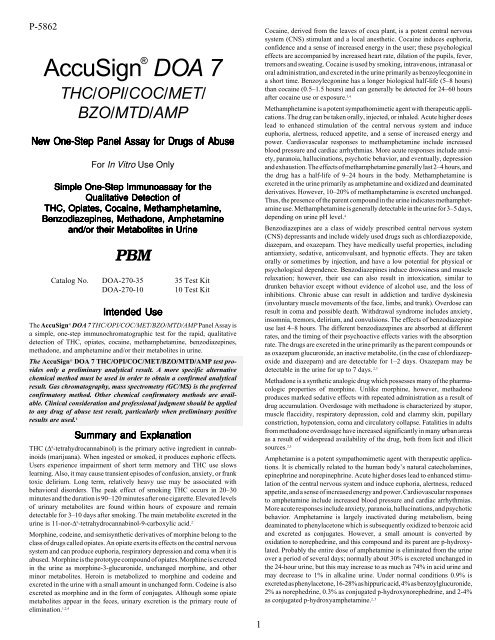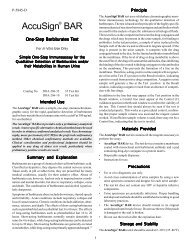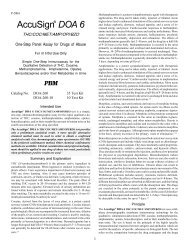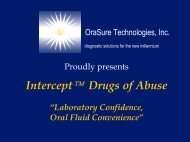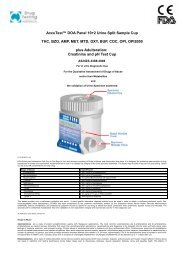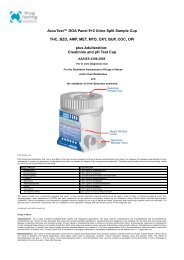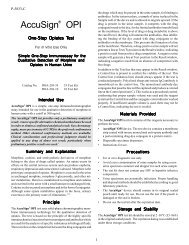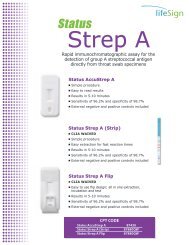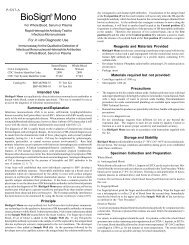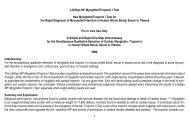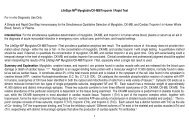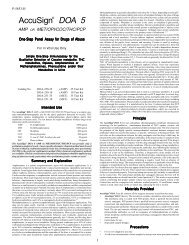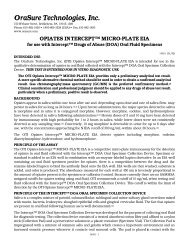AccuSign DOA 7.pdf - Drug Testing
AccuSign DOA 7.pdf - Drug Testing
AccuSign DOA 7.pdf - Drug Testing
Create successful ePaper yourself
Turn your PDF publications into a flip-book with our unique Google optimized e-Paper software.
P-5862<br />
<strong>AccuSign</strong> ® <strong>DOA</strong> 7<br />
THC/OPI/COC/MET/<br />
BZO/MTD/AMP<br />
New One-Step Panel Assay for <strong>Drug</strong>s of Abuse<br />
For In Vitro Use Only<br />
Simple One-Step Immunoassay for the<br />
Qualitative Detection of<br />
THC, Opiates, Cocaine, Methamphetamine,<br />
Benzodiazepines, Methadone, Amphetamine<br />
and/or their Metabolites in Urine<br />
PBM<br />
Catalog No. <strong>DOA</strong>-270-35 35 Test Kit<br />
<strong>DOA</strong>-270-10 10 Test Kit<br />
Intended Use<br />
The <strong>AccuSign</strong> ® <strong>DOA</strong> 7 THC/OPI/COC/MET/BZO/MTD/AMP Panel Assay is<br />
a simple, one-step immunochromatographic test for the rapid, qualitative<br />
detection of THC, opiates, cocaine, methamphetamine, benzodiazepines,<br />
methadone, and amphetamine and/or their metabolites in urine.<br />
The <strong>AccuSign</strong> ® <strong>DOA</strong> 7 THC/OPI/COC/MET/BZO/MTD/AMP test provides<br />
only a preliminary analytical result. A more specific alternative<br />
chemical method must be used in order to obtain a confirmed analytical<br />
result. Gas chromatography, mass spectrometry (GC/MS) is the preferred<br />
confirmatory method. Other chemical confirmatory methods are available.<br />
Clinical consideration and professional judgment should be applied<br />
to any drug of abuse test result, particularly when preliminary positive<br />
results are used. 1 Summary and Explanation<br />
THC (∆ 9 -tetrahydrocannabinol) is the primary active ingredient in cannabinoids<br />
(marijuana). When ingested or smoked, it produces euphoric effects.<br />
Users experience impairment of short term memory and THC use slows<br />
learning. Also, it may cause transient episodes of confusion, anxiety, or frank<br />
toxic delirium. Long term, relatively heavy use may be associated with<br />
behavioral disorders. The peak effect of smoking THC occurs in 20–30<br />
minutes and the duration is 90–120 minutes after one cigarette. Elevated levels<br />
of urinary metabolites are found within hours of exposure and remain<br />
detectable for 3–10 days after smoking. The main metabolite excreted in the<br />
urine is 11-nor-∆ 9 -tetrahydrocannabinol-9-carboxylic acid. 2<br />
Morphine, codeine, and semisynthetic derivatives of morphine belong to the<br />
class of drugs called opiates. An opiate exerts its effects on the central nervous<br />
system and can produce euphoria, respiratory depression and coma when it is<br />
abused. Morphine is the prototype compound of opiates. Morphine is excreted<br />
in the urine as morphine-3-glucuronide, unchanged morphine, and other<br />
minor metabolites. Heroin is metabolized to morphine and codeine and<br />
excreted in the urine with a small amount in unchanged form. Codeine is also<br />
excreted as morphine and in the form of conjugates. Although some opiate<br />
metabolites appear in the feces, urinary excretion is the primary route of<br />
elimination. 1,2,4 1<br />
Cocaine, derived from the leaves of coca plant, is a potent central nervous<br />
system (CNS) stimulant and a local anesthetic. Cocaine induces euphoria,<br />
confidence and a sense of increased energy in the user; these psychological<br />
effects are accompanied by increased heart rate, dilation of the pupils, fever,<br />
tremors and sweating. Cocaine is used by smoking, intravenous, intranasal or<br />
oral administration, and excreted in the urine primarily as benzoylecgonine in<br />
a short time. Benzoylecgonine has a longer biological half-life (5–8 hours)<br />
than cocaine (0.5–1.5 hours) and can generally be detected for 24–60 hours<br />
after cocaine use or exposure. 3,4<br />
Methamphetamine is a potent sympathomimetic agent with therapeutic applications.<br />
The drug can be taken orally, injected, or inhaled. Acute higher doses<br />
lead to enhanced stimulation of the central nervous system and induce<br />
euphoria, alertness, reduced appetite, and a sense of increased energy and<br />
power. Cardiovascular responses to methamphetamine include increased<br />
blood pressure and cardiac arrhythmias. More acute responses include anxiety,<br />
paranoia, hallucinations, psychotic behavior, and eventually, depression<br />
and exhaustion. The effects of methamphetamine generally last 2–4 hours, and<br />
the drug has a half-life of 9–24 hours in the body. Methamphetamine is<br />
excreted in the urine primarily as amphetamine and oxidized and deaminated<br />
derivatives. However, 10–20% of methamphetamine is excreted unchanged.<br />
Thus, the presence of the parent compound in the urine indicates methamphetamine<br />
use. Methamphetamine is generally detectable in the urine for 3–5 days,<br />
depending on urine pH level. 4<br />
Benzodiazepines are a class of widely prescribed central nervous system<br />
(CNS) depressants and include widely used drugs such as chlordiazepoxide,<br />
diazepam, and oxazepam. They have medically useful properties, including<br />
antianxiety, sedative, anticonvulsant, and hypnotic effects. They are taken<br />
orally or sometimes by injection, and have a low potential for physical or<br />
psychological dependence. Benzodiazepines induce drowsiness and muscle<br />
relaxation; however, their use can also result in intoxication, similar to<br />
drunken behavior except without evidence of alcohol use, and the loss of<br />
inhibitions. Chronic abuse can result in addiction and tardive dyskinesia<br />
(involuntary muscle movements of the face, limbs, and trunk). Overdose can<br />
result in coma and possible death. Withdrawal syndrome includes anxiety,<br />
insomnia, tremors, delirium, and convulsions. The effects of benzodiazepine<br />
use last 4–8 hours. The different benzodiazepines are absorbed at different<br />
rates, and the timing of their psychoactive effects varies with the absorption<br />
rate. The drugs are excreted in the urine primarily as the parent compounds or<br />
as oxazepam glucuronide, an inactive metabolite, (in the case of chlordiazepoxide<br />
and diazepam) and are detectable for 1–2 days. Oxazepam may be<br />
detectable in the urine for up to 7 days. 2,3<br />
Methadone is a synthetic analogic drug which possesses many of the pharmacologic<br />
properties of morphine. Unlike morphine, however, methadone<br />
produces marked sedative effects with repeated administration as a result of<br />
drug accumulation. Overdosage with methadone is characterized by stupor,<br />
muscle flaccidity, respiratory depression, cold and clammy skin, pupillary<br />
constriction, hypotension, coma and circulatory collapse. Fatalities in adults<br />
from methadone overdosage have increased significantly in many urban areas<br />
as a result of widespread availability of the drug, both from licit and illicit<br />
sources. 2,3<br />
Amphetamine is a potent sympathomimetic agent with therapeutic applications.<br />
It is chemically related to the human body’s natural catecholamines,<br />
epinephrine and norepinephrine. Acute higher doses lead to enhanced stimulation<br />
of the central nervous system and induce euphoria, alertness, reduced<br />
appetite, and a sense of increased energy and power. Cardiovascular responses<br />
to amphetamine include increased blood pressure and cardiac arrhythmias.<br />
More acute responses include anxiety, paranoia, hallucinations, and psychotic<br />
behavior. Amphetamine is largely inactivated during metabolism, being<br />
deaminated to phenylacetone which is subsequently oxidized to benzoic acid<br />
and excreted as conjugates. However, a small amount is converted by<br />
oxidation to norephedrine, and this compound and its parent are p-hydroxylated.<br />
Probably the entire dose of amphetamine is eliminated from the urine<br />
over a period of several days; normally about 30% is excreted unchanged in<br />
the 24-hour urine, but this may increase to as much as 74% in acid urine and<br />
may decrease to 1% in alkaline urine. Under normal conditions 0.9% is<br />
excreted as phenylacetone, 16-28% as hippuric acid, 4% as benzoylglucuronide,<br />
2% as norephedrine, 0.3% as conjugated p-hydroxynorephedrine, and 2-4%<br />
as conjugated p-hydroxyamphetamine. 2, 5
Add 3 drops<br />
(110 µL) in<br />
each sample<br />
well<br />
Read in<br />
5–10<br />
minutes<br />
(1)<br />
CONTROL (VALIDATION) LINE (C).<br />
The Control/Validation line indicates:<br />
1. If the proper amount of sample was used;<br />
2. If the sample wicked;<br />
3. If the procedure was followed properly.<br />
If no control line appears, the test is NOT VALID.<br />
Repeat the test using a new device, and follow the<br />
procedure carefully.<br />
(2) (3) (4)<br />
OR<br />
OR<br />
THC (–)<br />
OPI (–)<br />
COC (–)<br />
MET (–)<br />
BZO (–)<br />
MTD (–)<br />
AMP (–)<br />
THC (–)<br />
OPI (+)<br />
COC (–)<br />
MET (+)<br />
(5)<br />
BZO (–)<br />
MTD (+)<br />
AMP (+)<br />
THC (+)<br />
OPI (–)<br />
COC (+)<br />
MET (–)<br />
BZO (+)<br />
MTD (–)<br />
AMP (–)<br />
THC (+)<br />
OPI (+)<br />
COC (–)<br />
MET (–)<br />
BZO (+)<br />
MTD (+)<br />
AMP (+)<br />
. . . etc.<br />
INVALID<br />
Principle<br />
The <strong>AccuSign</strong> ® <strong>DOA</strong> 7 test uses solid-phase chromatographic membrane<br />
immunoassay technology for the qualitative, simultaneous detection of THC,<br />
opiates, cocaine, methamphetamine, benzodiazepines, methadone, and amphetamine<br />
in human urine. The test is based on the principle of the highly<br />
specific immunochemical reactions between antigens and antibodies which<br />
are used for the analysis of specific substances in biological fluids. The test<br />
relies on the competition between the drug conjugates and the drugs which may<br />
be present in the urine sample, for binding to antibodies. In the test procedure,<br />
a sample of urine is placed in the Sample well of the device and is allowed to<br />
migrate upward. If the drug is present in the urine sample, it competes with the<br />
drug conjugate bound to the dye, for the limited antibodies immobilized on the<br />
membrane. If the level of drug or drug metabolite is above the cutoff level, the<br />
drug will saturate the antibodies, thus inhibiting the binding of the dye coated<br />
with drug conjugates to the antibodies on the membrane. This prevents the<br />
formation of a line on the membrane. Therefore, a drug-positive urine sample<br />
will not generate a line at the specific drug position in the Result window,<br />
indicating a positive result. A negative urine sample will generate a line at the<br />
specific drug position in the Result window, indicating a negative result. The<br />
same principle of competition is applicable where the drug conjugate is<br />
immobilized on the membrane and the antibody is coated on the dye.<br />
In addition to the Test line(s) that may appear in the Result window, a Control<br />
line is present to confirm the viability of the test. This Control line (validation<br />
line) should always appear if the test is conducted properly. Polyclonal sheep<br />
anti-mouse IgG antibody is immobilized on the control line. The monoclonal<br />
antibody-dye conjugates that pass the line will be captured and produce a<br />
colored line at the Control position (C). This works as a procedural control,<br />
confirming that proper sample volume was used and the reagent system at the<br />
Control line and the conjugate-color indicator worked properly. If insufficient<br />
sample volume is used, there may not be a Control line, indicating the test is<br />
invalid.<br />
Materials Provided<br />
The <strong>AccuSign</strong> ® <strong>DOA</strong> 7 test kit contains all the reagents necessary to perform<br />
the assay.<br />
• <strong>AccuSign</strong> ® <strong>DOA</strong> 7 device. The test device contains a membrane strip and<br />
a dye pad. Membrane strips are coated with THC-protein (a purified<br />
bovine protein) conjugate, monoclonal anti-morphine, antibenzoylecgonine,<br />
anti-methamphetamine, anti-methadone, and anti-amphetamine<br />
antibodies as well as polyclonal anti-benzodiazepine antibody.<br />
Sheep anti-mouse antibody is coated for the control band. Dye pads<br />
contain colloidal gold coated with monoclonal anti-THC antibody as well<br />
as conjugates of morphine, benzoylecgonine, methamphetamine, oxazepam,<br />
methadone, and amphetamine (each drug is conjugated with a<br />
purified bovine protein).<br />
• Disposable sample dispenser.<br />
• Instructions for use.<br />
Precautions<br />
• For in vitro diagnostic use only.<br />
• Avoid cross contamination of urine samples by using a new<br />
urine specimen container and dropper for each urine sample.<br />
• This test kit does not contain any HIV or hepatitis infective components.<br />
• Urine specimens are potentially infectious. Proper handling and disposal<br />
methods should be followed, according to good laboratory practices.<br />
• The <strong>AccuSign</strong> ® device should remain in its original sealed pouch until<br />
ready for use.<br />
• Do not use the test kit after the expiration date.<br />
Storage and Stability<br />
The <strong>AccuSign</strong> ® <strong>DOA</strong> 7 test kit should be stored at 2–30°C (35–86°F) in the<br />
original sealed pouch. The expiration dating was established under these<br />
storage conditions.<br />
Specimen Collection and Preparation<br />
Approximately 110 µL of urine sample is required for each test sample well.<br />
Fresh urine specimens do not require any special handling or pretreatment.<br />
Specimens should be collected in a clean glass or plastic container. If testing<br />
will not be performed immediately, specimens should be refrigerated (2–8°C)<br />
or frozen. Frozen specimens must be completely thawed, and thoroughly<br />
mixed before using.<br />
Specimens containing a large amount of particulate matter may give inconsistent<br />
test results. Such specimens should be clarified by centrifuging or allowing<br />
to settle before testing.<br />
2
Test Procedure<br />
The test procedure consists of adding the urine sample to each of two Sample<br />
wells of the device and watching for the appearance of colored lines in both<br />
result windows.<br />
Test Protocol<br />
1. For each test, open one <strong>AccuSign</strong> ® <strong>DOA</strong> 7 pouch<br />
and label the device with the patient ID.<br />
2. Holding the dropper vertically, dispense 3 full drops<br />
(110 µL) of the urine sample into each Sample well.<br />
3. Read the result after 5 minutes, but within 10 minutes.<br />
Interpretation of Results<br />
Negative: The appearance of a reddish-purple Control line (C) and a line for<br />
a specific drug indicates a negative test result; i.e., no drug above the cutoff level<br />
has been detected. The color intensities of the Control line and a specific drug<br />
line may not be equal. Any faint line at a specific drug name in the Result<br />
window, visible in 10 minutes, should be interpreted as negative. A negative<br />
test result does not indicate the absence of drug in the sample; it only indicates<br />
the sample does not contain drug above the cutoff level in qualitative terms.<br />
Positive: The appearance of a reddish-purple Control line and no distinct line<br />
at a specific drug name indicates the test result is positive for that drug (i.e., the<br />
specimen contains the drug at a concentration above the cutoff level). A positive<br />
test result does not provide any indication of the level of intoxication or urinary<br />
concentration of the drug in the sample; it only indicates the sample contains<br />
drug above the cutoff level in qualitative terms.<br />
Invalid: A distinct Control line (C) should always appear. The test is invalid<br />
if no Control line forms at the C position. Such tests should be repeated with a<br />
new <strong>AccuSign</strong> ® <strong>DOA</strong> 7 test device.<br />
Examples of possible results are shown in the diagram in page 2.<br />
(1) THC (–), Opiates (–), Cocaine (–), Methamphetamines (–), Benzodiazepines<br />
(–), Methadone (–), Amphetamine (–): Nine reddish-purple<br />
lines—one line each at the C positions and one each at the THC, OPI,<br />
COC, MET, BZO, MTD, and AMP positions.<br />
(2) THC (–), Opiates (+), Cocaine (–), Methamphetamines (+), Benzodiazepines<br />
(–), Methadone (+), Amphetamine (+): Five reddish-purple<br />
lines—one line each at the C positions and one line each at the THC, COC<br />
and BZO positions; no line at the OPI, MET, MTD, and AMP positions.<br />
(3) THC (+), Opiates (–), Cocaine (+), Methamphetamines (–), Benzodiazepines<br />
(+), Methadone (–), Amphetamine (–): Six reddish-purple<br />
lines—one line each at the C positions and one line each at the OPI, MET,<br />
MTD and AMP positions; no line at the THC, COC, and BZO positions.<br />
(4) THC (+), Opiates (+), Cocaine (–), Methamphetamines (–), Benzodiazepines<br />
(+), Methadone (+), Amphetamine (+): Four reddish-purple<br />
lines—one line each at the C positions and one line each at the COC and<br />
MET positions; no line at the THC, OPI, BZO, MTD, and AMP positions.<br />
(5) Invalid: No line at the C position.<br />
There are other possible results, depending on the combinations of drugs present<br />
in the urine sample.<br />
Limitations<br />
• The test is designed for use with unadulterated urine only.<br />
• There is a possibility that factors such as technical or procedural errors, as<br />
well as other substances in the urine sample than those listed in Table 12<br />
below, may interfere with the test and cause erroneous results.<br />
• Adulterants, such as bleach and/or alum, in urine specimens may produce<br />
erroneous results regardless of the method of analysis. If adulteration is<br />
suspected, the test should be repeated with a new sample.<br />
• The test result read after 10 minutes may not be consistent with the original<br />
reading obtained within the 10 minute reading period. The test result must<br />
be read within 10 minutes of sample application.<br />
• Certain medications containing opiates or opiate derivatives or methamphetamines<br />
may produce a positive result. Additionally, foods and tea<br />
containing poppy products and/or coca leaves may produce a positive<br />
result. Prolonged passive smoking of THC may also produce a positive<br />
result.<br />
User Quality Control<br />
Internal Control: Each <strong>AccuSign</strong> ®®® <strong>DOA</strong> 7 test device has a built-in control.<br />
The Control line is an internal positive procedural control. A distinct reddishpurple<br />
Control line should appear in the Control position, if the test procedure<br />
is performed properly, an adequate sample volume is used, the sample and<br />
reagent are wicking on the membrane, and the test reagents at the control line<br />
and the conjugate-color indicator are reactive. In addition, if the test is<br />
performed correctly and the device is working properly, the background in the<br />
Result window will become clear and provide a distinct result. This may be<br />
considered an internal negative procedural control.<br />
The positive and negative procedural controls contained in each <strong>AccuSign</strong> ®<br />
<strong>DOA</strong> 7 test device satisfy the requirements of testing a positive control and a<br />
negative control on a daily basis. If the Control line does not appear in the<br />
Control position, the test is invalid and a new test should be performed. If the<br />
problem persists, contact PBM for technical assistance.<br />
External Control: External controls may also be used to assure that the reagents<br />
are working properly and that the assay procedure is followed correctly. It is<br />
recommended that a control be tested at regular intervals as good laboratory<br />
testing practice. For information on how to obtain controls, contact PBM’s<br />
Technical Services.<br />
Expected Values<br />
<strong>AccuSign</strong> ® <strong>DOA</strong> 7 THC/OPI/COC/MET/BZO/MTD/AMP is a qualitative test.<br />
The amount of THC, opiates, cocaine, methamphetamine, benzodiazepines,<br />
methadone, amphetamine, and/or their metabolites present in the urine cannot<br />
be estimated by the test. The test results distinguish positive from negative<br />
samples. Positive results indicate the samples contain THC, opiates, cocaine,<br />
methamphetamine, benzodiazepines, methadone, amphetamine, and/or their<br />
metabolites above the cutoff concentration. The <strong>AccuSign</strong> ® <strong>DOA</strong> 7 test has<br />
been shown to detect following cutoff level for each drug: 50 ng/mL of THC,<br />
300 ng/mL of morphine, 300 ng/mL of benzoylecgonine, 1000 ng/mL of<br />
methamphetamine, 300 ng/mL of oxazepam, 300 ng/mL of methadone, and<br />
1000 ng/mL of amphetamine and in urine.<br />
Performance Characteristics<br />
The accuracy of <strong>AccuSign</strong> ® <strong>DOA</strong> 7 THC/OPI/COC/MET/BZO/MTD/AMP test<br />
was evaluated in comparison to a commercially available immunoassay<br />
<strong>AccuSign</strong> ® THC, <strong>AccuSign</strong> ® OPI, <strong>AccuSign</strong> ® COC, <strong>AccuSign</strong> ® MET,<br />
<strong>AccuSign</strong> ® BZO, <strong>AccuSign</strong> ® MTD and <strong>AccuSign</strong> ® AMP which are proven to<br />
be substantially equivalent to Syva’s Emit II. The results are shown in Tables<br />
1, 2, 3, 4, 5, 6, and 7. A complete agreement (100 %) was observed.<br />
Table 1. THC Accuracy: Comparison of <strong>AccuSign</strong> ® <strong>DOA</strong> 7 with <strong>AccuSign</strong> ®<br />
THC<br />
<strong>AccuSign</strong> ® THC<br />
Positive Negative Total<br />
<strong>AccuSign</strong> ® <strong>DOA</strong> 7 Positive 150 0 150<br />
(THC) Negative 200 200<br />
Total 150 200 350<br />
Table 2. Opiates Accuracy: Comparison of <strong>AccuSign</strong> ® <strong>DOA</strong> 7 with <strong>AccuSign</strong> ®<br />
OPI<br />
<strong>AccuSign</strong> ® OPI<br />
Positive Negative Total<br />
<strong>AccuSign</strong> ® <strong>DOA</strong> 7 Positive 150 0 150<br />
(OPI) Negative 0 200 200<br />
Total 150 200 350<br />
3
Table 3. Cocaine Accuracy: Comparison of <strong>AccuSign</strong> ® <strong>DOA</strong> 7 with <strong>AccuSign</strong> ®<br />
COC<br />
<strong>AccuSign</strong> ® COC<br />
Positive Negative Total<br />
<strong>AccuSign</strong> ® <strong>DOA</strong> 7 Positive 150 0 150<br />
(COC) Negative 0 200 200<br />
Total 150 200 350<br />
Table 4. Methamphetamine Accuracy: Comparison of <strong>AccuSign</strong> ® <strong>DOA</strong> 7<br />
with <strong>AccuSign</strong> ® MET<br />
<strong>AccuSign</strong> ® MET<br />
Positive Negative Total<br />
<strong>AccuSign</strong> ® <strong>DOA</strong> 7 Positive 96 0 96<br />
(MET) Negative 0 150 150<br />
Total 96 150 246<br />
Table 5. Benzodiazepine Accuracy: Comparison of <strong>AccuSign</strong> ® <strong>DOA</strong> 7 with<br />
<strong>AccuSign</strong> ® BZO<br />
<strong>AccuSign</strong> ® BZO<br />
Positive Negative Total<br />
<strong>AccuSign</strong> ® <strong>DOA</strong> 7 Positive 174 0 174<br />
(BZO) Negative 0 200 200<br />
Total 174 200 374<br />
Table 6. Methadone Accuracy: Comparison of <strong>AccuSign</strong> ® <strong>DOA</strong> 7 with<br />
<strong>AccuSign</strong> ® MTD<br />
<strong>AccuSign</strong> ® MTD<br />
Positive Negative Total<br />
<strong>AccuSign</strong> ® <strong>DOA</strong> 7 Positive 100 0 100<br />
(MTD) Negative 0 153 153<br />
Total 100 153 253<br />
Table 7. Amphetamine Accuracy: Comparison of <strong>AccuSign</strong> ® <strong>DOA</strong> 7 with<br />
<strong>AccuSign</strong> ® AMP<br />
<strong>AccuSign</strong> ® AMP<br />
Positive Negative Total<br />
<strong>AccuSign</strong> ® <strong>DOA</strong> 7 Positive 98 0 98<br />
(AMP) Negative 0 200 200<br />
Total 98 200 298<br />
In a separate study, <strong>AccuSign</strong> ® <strong>DOA</strong> 7 THC/OPI/COC/MET/BZO/MTD/AMP<br />
test was evaluated against specimens confirmed as positive by GC/MS, for each<br />
of the 7 drugs. The results are shown in Table 8.<br />
Table 8. Comparison of <strong>AccuSign</strong> ® <strong>DOA</strong> 7 with GC/MS Assay<br />
Number <strong>AccuSign</strong> ®<br />
Concentration of <strong>DOA</strong> 7<br />
(GC/MS value) ng/mL Samples Result<br />
∆ 9 -THC-9-COOH 73 – 910 37 +<br />
34, 36, 37, 38, 39 5 –<br />
Morphine 362 - 172440 31 +<br />
192, 215, 226, 230 4 –<br />
Benzoylecgonine 371 – 64800 41 +<br />
220, 220, 224, 225, 271 5 –<br />
Methamphetamine 1463 - 5227 15 +<br />
706, 750, 770, 860 4 –<br />
Oxazepam 370 – 8641 28 +<br />
210, 225, 230 3 –<br />
Methadone 307 –6523 43 +<br />
183, 220, 225 3 –<br />
Amphetamine 1269 – 16000 40 +<br />
717, 824, 847, 866, 870, 780 6 –<br />
Precision<br />
The precision of the <strong>AccuSign</strong> ® <strong>DOA</strong> 7 test was determined by two people on<br />
five different days with serially diluted each standard drug solutions. All<br />
samples containing 50% below cutoff level of the drug showed negative results.<br />
All samples containing 50 % above cutoff level of the drug showed positive<br />
results. The study also included 20 samples of 25% below cutoff level and 20<br />
samples of 25 % above cutoff level for each of the 7 drugs. The results are<br />
summarized below.<br />
Table 9. Precision Study<br />
THC Test<br />
<strong>Drug</strong> Conc. Number Positive Negative %<br />
(ng/mL) of Tested (+) (–) Agreement<br />
25 20 0 20 100<br />
37.5 20 0 20 100<br />
62.5 20 19 1 95<br />
75 20 20 0 100<br />
Opiates Test<br />
<strong>Drug</strong> Conc. Number Positive Negative %<br />
(ng/mL) of Tested (+) (–) Agreement<br />
150 20 0 20 100<br />
225 20 0 20 100<br />
375 20 20 0 100<br />
450 20 20 0 100<br />
Cocaine Test<br />
<strong>Drug</strong> Conc. Number Positive Negative %<br />
(ng/mL) of Tested (+) (–) Agreement<br />
150 20 0 20 100<br />
225 20 0 20 100<br />
375 20 20 0 100<br />
450 20 20 0 100<br />
Methamphetamine Test<br />
<strong>Drug</strong> Conc. Number Positive Negative %<br />
(ng/mL) of Tested (+) (–) Agreement<br />
500 20 0 20 100<br />
750 20 0 20 100<br />
1250 20 18 2 90<br />
1500 20 20 0 100<br />
Benzodiazepine Test<br />
<strong>Drug</strong> Conc. Number Positive Negative %<br />
(ng/mL) of Tested (+) (–) Agreement<br />
150 20 0 20 100<br />
225 20 0 20 100<br />
375 20 19 1 95<br />
450 20 20 0 100<br />
Methadone Test<br />
<strong>Drug</strong> Conc. Number Positive Negative %<br />
(ng/mL) of Tested (+) (–) Agreement<br />
150 20 0 20 100<br />
225 20 0 20 100<br />
375 20 19 1 95<br />
450 20 20 0 100<br />
4
Amphetamine Test<br />
<strong>Drug</strong> Conc. Number Positive Negative %<br />
(ng/mL) of Tested (+) (–) Agreement<br />
500 20 0 20 100<br />
750 20 0 20 100<br />
1250 20 17 3 85<br />
1500 20 20 0 100<br />
Distribution of Random Error<br />
Forty blind samples for each drug were prepared by spiking various<br />
concentrations of each of the 7 drugs and separately tested by two<br />
operators. The tested concentrations were 0, 50% below cutoff, 50%<br />
above cutoff and 100% above cutoff for each drug. The test results from<br />
the two operators showed complete agreement.<br />
Reproducibility<br />
The reproducibility of the <strong>AccuSign</strong> ® <strong>DOA</strong> 7 test was examined at three<br />
different sites using a total of 55 blind controls. These consisted of five negative<br />
samples, five 50% below cutoff level samples, five 100% above cutoff level<br />
samples for each of the 7 drugs. The results obtained at these three sites with<br />
these controls demonstrated 100% agreement with each other.<br />
Specificity<br />
The following table lists compounds that are detected by the <strong>AccuSign</strong> ® <strong>DOA</strong><br />
7 test. The specificity of the <strong>AccuSign</strong> ® <strong>DOA</strong> 7 test was determined by adding<br />
various drugs and drug metabolites to drug-negative urine specimens and testing<br />
with the <strong>AccuSign</strong> ® <strong>DOA</strong> 7 test. The results are expressed in terms of the<br />
minimum concentration required to produce a positive result (Table 10).<br />
Table 10. Specificity<br />
Compound Concentration (ng/mL)<br />
THC<br />
Cannabinol 50,000<br />
11-nor-∆ 8 -THC-9-COOH 250<br />
11-nor-∆ 9 -THC-9-COOH 50<br />
∆ 8 -THC 25,000<br />
∆ 9 -THC 15,000<br />
11-hydroxy-∆ 9 -THC 10,000<br />
OPI<br />
Codeine 300<br />
Hydrocodone 500<br />
Hydromorphone 600<br />
Levophanol 5,000<br />
Meperidine 80,000<br />
Morphine 300<br />
Morphine-3-ß-D-glucuronide 500<br />
Nalorphine 1,000<br />
Naloxane 100,000<br />
Norcodeine 60,000<br />
Oxycodone 20,000<br />
Oxymorphone 60,000<br />
Procaine HCl 100,000<br />
Thebaine 5,000<br />
COC<br />
Benzoylecgonine 300<br />
Cocaine HCl 300<br />
Ecgonine HCl >100,000<br />
MET<br />
D-Amphetamine 200,000<br />
D,L-Amphetamine >200,000<br />
(–)Ephedrine >200,000<br />
(+)Ephedrine 200,000<br />
D-Methamphetamine 1,000<br />
p-OH-Methamphetamine >200,000<br />
Methylenedioxyamphetamine >200,000<br />
Methylenedioxymethamphetamine 5,000<br />
5<br />
BZO<br />
Alprazolam 10,000<br />
Bromazepam 2,500<br />
Chlordiazepoxide 1,000<br />
Clobazam 10,000<br />
Clonazepam 10,000<br />
Clorzepate dipotassium 250<br />
Delorazepam 1,000<br />
N-Desalkylflurazepam 1,250<br />
Diazepam 2,000<br />
Estazolam 500<br />
Flunitrazepam >10,000<br />
7-amino flunitrazepam 4,000<br />
a-Hydroxyalprazolam 250<br />
a-Hydroxytriazolam 2,500<br />
Lorazepam 750<br />
Lormetazepam 8,000<br />
Medazepam 2,500<br />
Midazolam 4,000<br />
Nitrazepam 2,500<br />
Nordiazepam (N-Desmethyldiazepam) 500<br />
Oxazepam 300<br />
Prazepam 9,000<br />
Temazepam 800<br />
Triazolam >10,000<br />
MTD<br />
Diphenhydramine 100,000<br />
Doxylamine >100,000<br />
EDDP >100,000<br />
EMDP >100,000<br />
Imipramine >100,000<br />
LAAM 2,000<br />
Meperidine >100,000<br />
Methadone 300<br />
Nor-LAAM 10,000<br />
AMP<br />
D-Amphetamine 1,000<br />
D,L-Amphetamine 1,500<br />
L-Amphetamine 60,000<br />
Benzphetamine >100,000<br />
d-Methamphetamine >100,000<br />
p-OH-Methamphetamine >100,000<br />
Methylenedioxyamphetamine 700<br />
Methlyenedioxymethamphetamine >100,000<br />
ß-Phenethylamine 60,000<br />
l-Phenylpropanolamine >100,000<br />
Phentermine 350<br />
Tryptamine 50,000<br />
Tyramine 70,000<br />
3-OH-Tyramine >100,000<br />
Endogenous compounds:<br />
Interfering Substances<br />
The <strong>AccuSign</strong> ® <strong>DOA</strong> 7 test showed no interference when the endogenous<br />
compounds were added at the concentrations given below to urine samples<br />
which had + 25 % cutoff concentration of each of the 7 drugs (Table 11).<br />
Table 11. Endogenous Compounds<br />
Substance Added<br />
Concentration<br />
Bilirubin<br />
Creatinine<br />
Glucose<br />
Hemoglobin<br />
b-Hydroxybutyric Acid<br />
(Ketone Body)<br />
Protein<br />
Sodium Chloride<br />
Sodium Nitrite<br />
2 mg/dl<br />
20 mg/dl<br />
1500 mg/dl<br />
25 mg/dl<br />
100 mg/dl<br />
2000 mg/dl<br />
1500 mg/dl<br />
100 mg/dl
Exogenous compounds:<br />
The following compounds showed no cross-reactivity when tested with the<br />
<strong>AccuSign</strong> ® <strong>DOA</strong> 7 THC/OPI/COC/MET/BZO/MTD/AMP at a concentration of<br />
100 µg/mL (Table 12).<br />
Table 12. Non Cross-Reacting Compounds<br />
4-Acetamidophenol<br />
Acetophenetidin (Phenacetin)<br />
N-Acetylprocainamide<br />
Acetylsalicylic acid<br />
Aminopyrine<br />
Amoxapine<br />
Amoxicillin<br />
Apomorphine<br />
Aspartame<br />
Atropine<br />
Benzilic acid<br />
Benzoic acid<br />
Benzphetamine<br />
Chloralhydrate<br />
Chloramphenicol<br />
Chlorothiazide<br />
Chlorquine<br />
Cholesterol<br />
Clonidine<br />
Cortisone<br />
(–) Cotinine<br />
Deoxycorticosterone<br />
Dextromethorphan<br />
Diclofenac<br />
Diethylpropion<br />
Diflunisal<br />
Digoxin<br />
Domperidone<br />
Doxylamine<br />
Erythromycin<br />
ß-Estradiol<br />
Estrone-3-sulfate<br />
Ethyl-p-aminobenzoate<br />
Fenoprofen<br />
Furoxmide<br />
Gentisic acid<br />
Glutethimide<br />
Guaifenesin<br />
Hippuric acid<br />
Hydralazine<br />
Hydrochlorothiazide<br />
Hydrocortisone<br />
O-Hydroxyhippuric acid<br />
Iproniazid<br />
(–) Isoproterenol<br />
Isoxsuprine<br />
Ketoprofen<br />
Labetalol<br />
Lidocaine<br />
Loperamide<br />
Loxapine succinate<br />
Meprobamate<br />
Methaqualone<br />
Methoxyphenamine<br />
Methylphenidate<br />
Methyprylon<br />
Nalidixic acid<br />
Naltrexone<br />
Naproxen<br />
Niacinamide<br />
Nifedipine<br />
Norethindrone<br />
Noroxymorphone<br />
D-Norpropoxyphene<br />
(–) Norpseudoephedrine<br />
Noscapine<br />
Nylidrin<br />
D,L-Octopamine<br />
Oxalic acid<br />
Oxolinic acid<br />
Oxymetazoline<br />
Papaverine<br />
Penicillin-G<br />
Pentazocaine<br />
Phendimetrazine<br />
Phenelzine<br />
Prednisolone<br />
Prednisone<br />
Promethazine<br />
D,L-Propanolol<br />
Propiomazine<br />
D-Propoxyphene<br />
Quinidine<br />
Quinine<br />
Rantidine<br />
Salicylic acid<br />
Serotonin<br />
Sulfamethazine<br />
Sulindac<br />
Tetracycline<br />
Tetrahydrocortisone<br />
Tetrahydrozoline<br />
Thiamine<br />
Thioridazine<br />
D,L-Thyroxine<br />
Tolbutamide<br />
Triamterene<br />
Trifluoperazine<br />
Trimethoprim<br />
D,L-Tryptophan<br />
D,L-Tyrosine<br />
Uric acid<br />
Verapamil<br />
Zomepirac<br />
References<br />
1. Tietz, Norbert W. Textbook of Clinical Chemistry. W.B. Saunders Company.<br />
1986, p. 1735.<br />
2. Hawks RL, Chiang CN, eds. Urine <strong>Testing</strong> for <strong>Drug</strong>s of Abuse. National<br />
Institute on <strong>Drug</strong> Abuse (NIDA), Research Monograph 73; 1986.<br />
3. Baselt RC. Disposition of Toxic <strong>Drug</strong>s and Chemicals in Man. 2nd Ed.,<br />
Davis, CA: Biomedical Publ.; 1982; p.488.<br />
4. Stewart DJ, Inoba T, Ducassen M, and Kalow W. Clin. Pharmacol. Ther.<br />
1979;25: 264–8.<br />
5. Ambre JJ. Anal. Toxicol. 1985;9:241–5.<br />
6. Blum K. Handbook of Abusable <strong>Drug</strong>s. 1st ed. New York: Gardner Press,<br />
Inc.; 1984.<br />
7. Fairlight Consulting. http://www.fairlite.com/ocd/articles/tricyclics.html<br />
8. Bickel MH. Poisoning by Tricyclic Antidepressant <strong>Drug</strong>s. Int. J. Clinical<br />
Pharmacol. 11 (1975) 145-176 (No. 2).<br />
Symbols Key<br />
Manufactured by<br />
CE Mark<br />
Authorized Representative<br />
In Vitro Diagnostic Medical Device<br />
Catalog Number<br />
Consult Instructions for Use<br />
Batch Code<br />
“Use By” date in year-month-day format<br />
Temperature Limitation<br />
Contains sufficient for tests<br />
Do not reuse<br />
Contents<br />
Test Device<br />
Transfer Pipette<br />
Instructions for Use<br />
One-step immunochromatographic Assay for<br />
the Detection of <strong>Drug</strong>s of Abuse in Urine<br />
<strong>AccuSign</strong> ® is a Registered Trademark of Princeton BioMeditech Corporation.<br />
Manufactured by<br />
Patent No.: 5,559,041<br />
© 2004 PBM<br />
Printed in U.S.A.<br />
Revised June 2004<br />
P-5862 0615BL<br />
6<br />
MT Promedt Consulting GmbH<br />
Eisenbahnstrasse 2<br />
D-66386 St. Ingbert<br />
Germany<br />
+49-68 94-58 10 20<br />
Princeton BioMeditech Corporation<br />
Princeton, NJ 08543-7139 U.S.A.<br />
1-732-274–1000 www.pbmc.com


